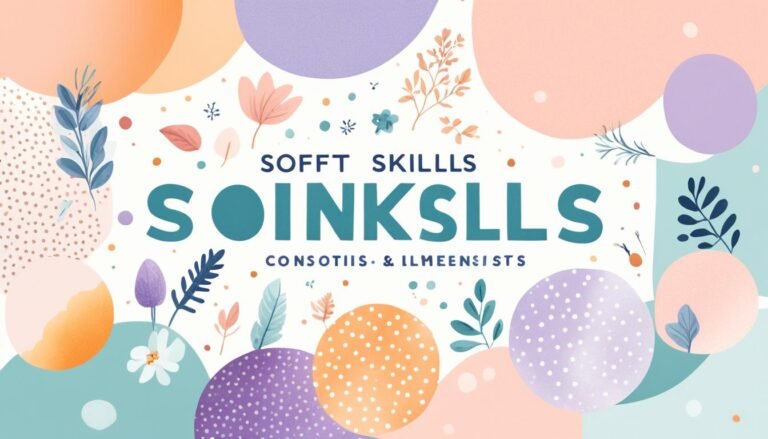Inclusive Communication as a Soft Skill
Embrace inclusive communication as an essential soft skill. It helps you connect with others, fostering empathy and understanding in diverse environments. Being inclusive builds strong relationships, essential for collaborative and respectful workplaces. When people feel valued, they engage effectively, boosting teamwork and morale. Setting the stage for open dialogue welcomes various perspectives, nurturing creativity and improving productivity. Want to enhance your communication skills further? You'll discover more strategies and benefits when exploring the impact of inclusive communication.
Key Takeaways
- Inclusive communication as a soft skill promotes empathy and collaboration.
- It involves active listening and respecting diverse perspectives.
- Cultivating inclusive communication enhances teamwork and productivity.
- Recognizing cultural nuances fosters effective interaction.
- Developing inclusive communication skills builds welcoming and diverse environments.
The Impact of Inclusive Communication
Understanding the impact of inclusive communication is essential for fostering empathy and building stronger relationships in diverse environments. Positive relationships are the cornerstone of a thriving workplace, where collaboration and mutual respect flourish. When individuals feel heard and valued, they're more likely to engage meaningfully with their colleagues, leading to a boost in morale and teamwork.
Inclusive communication sets the stage for open dialogue, where ideas can be freely exchanged, and different perspectives are welcomed. This environment of inclusivity not only nurtures creativity but also enhances workplace productivity.
Key Elements of Inclusive Communication
Embracing key elements of inclusive communication is fundamental for promoting understanding and collaboration in diverse settings. To communicate inclusively, it's essential to approach interactions with empathy and respect. Empathy involves actively listening to others, seeking to understand their perspectives, and acknowledging their feelings. When you show empathy in communication, you create a safe and open environment where everyone's voice is valued.
Respect in communication is another vital element of inclusivity. It means valuing the opinions and beliefs of others, even if they differ from your own. By demonstrating respect in your interactions, you foster mutual trust and encourage meaningful dialogue. Avoid making assumptions or judgments based on stereotypes, as this can hinder effective communication and lead to misunderstandings.
Inclusive communication is about creating connections, building relationships, and fostering a sense of belonging for everyone involved. By incorporating empathy and respect into your communication style, you can navigate diverse environments with sensitivity and understanding. Remember, every interaction is an opportunity to practice inclusivity and promote harmony among individuals from varied backgrounds.
Overcoming Barriers to Inclusive Communication
Let's tackle the barriers to inclusive communication together by actively listening, undergoing cultural sensitivity training, and using clear language. These strategies can help break down obstacles and create a more inclusive environment where everyone feels heard and understood.
Active Listening Techniques
To truly engage in inclusive communication, it's important to actively listen and overcome barriers that may hinder understanding and connection. An empathetic response is key to showing genuine interest in what the speaker is sharing.
When actively listening, practice open body language to signal receptiveness and respect. Maintain eye contact, nod, and use verbal cues like 'I see' or 'That makes sense' to demonstrate your engagement. Avoid interrupting or formulating a response before the speaker finishes.
Reflect on what's being said before offering your thoughts. By actively listening with empathy and open body language, you create a safe space for meaningful dialogue and foster stronger connections in your communication efforts.
Cultural Sensitivity Training
Overcome barriers to inclusive communication by participating in cultural sensitivity training. This training enhances your awareness and understanding of diverse perspectives and practices, which is essential in today's interconnected world.
Cultural awareness is crucial, as through diversity training, you can learn to appreciate different customs, beliefs, and values. This helps you avoid misunderstandings and promotes respect for all individuals, irrespective of their backgrounds.
By developing cultural sensitivity, you become more skilled at managing cross-cultural interactions and fostering positive relationships. Embracing cultural diversity not only enriches your communication skills but also contributes to a more harmonious and inclusive environment.
Clear Language Use
Improving your communication through clear language use is vital for overcoming barriers to inclusive interactions. When using plain language and effective messaging, you guarantee that your audience can easily grasp your message.
Clarity is essential in creating understanding and fostering inclusivity. Tailoring your language to the specific needs and preferences of your audience is critical for successful communication. By understanding your audience and communicating in a straightforward manner, you can bridge gaps and connect more effectively.
Avoiding jargon and complex terminology can help make your message more accessible to everyone. Remember, the goal is to make certain that your message is received and understood by all, regardless of their background or experience.
Strategies for Practicing Inclusive Communication
When fostering inclusive communication, consider incorporating diverse perspectives and actively listening to guarantee everyone feels heard and valued. Emotional intelligence plays a significant role in understanding others' feelings and perspectives. By being aware of your emotions and those of others, you can navigate conversations with sensitivity and empathy. Paying attention to body language is equally important. Nonverbal cues can convey a lot about a person's feelings and reactions. Make sure you maintain open body language and encourage others to do the same to create a welcoming environment for all voices to be heard.
To practice inclusive communication effectively, try to engage with a diverse range of individuals. This exposure will broaden your understanding of different backgrounds and viewpoints, making it easier to communicate inclusively. Additionally, be mindful of your language choices to avoid unintentionally excluding or offending others. Active listening, combined with empathy and openness, is key to fostering an inclusive communication environment where everyone feels respected and valued.
Benefits of Cultivating Inclusive Communication
To truly understand the value of inclusive communication, consider how it fosters a sense of belonging and respect among all individuals involved. When you prioritize inclusive communication, you create an environment where everyone feels heard and valued. This fosters improved collaboration as team members are more willing to share their ideas and perspectives, leading to better problem-solving and innovation.
Furthermore, cultivating inclusive communication enhances relationships by building trust and mutual understanding. When people feel included and respected in conversations, it strengthens the bond between team members and fosters a positive work culture. This, in turn, boosts morale and productivity, creating a more harmonious and effective team dynamic.
Inclusive Communication in Cross-Cultural Settings
Traversing cross-cultural settings requires a commitment to understanding and embracing diverse communication styles and perspectives. In intercultural understanding, effective collaboration is key to guiding the complexities of global interactions successfully. This involves appreciating the richness that diversity brings to communication styles and being open to learning from different cultural norms.
To help you better grasp the significance of inclusive communication in cross-cultural settings, let's explore a comparison between traditional communication and inclusive communication:
| Traditional Communication | Inclusive Communication |
|---|---|
| Assumes a universal approach to communication | Acknowledges and respects diverse communication styles |
| May lead to misunderstandings and conflicts | Fosters mutual understanding and harmony |
| Relies on one-size-fits-all strategies | Tailors communication to individual and cultural needs |
| Ignores cultural nuances | Embraces cultural nuances for effective interaction |
Developing Inclusive Communication Skills
Incorporating inclusive communication skills involves recognizing and embracing the diverse ways people express themselves, particularly in cross-cultural interactions. Building empathy is key to developing inclusive communication skills. To build empathy, actively listen to others, seek to understand their perspectives, and acknowledge the validity of their experiences. Remember that everyone's background shapes how they communicate and interpret information. Fostering understanding requires being open-minded and willing to learn from different communication styles.
Practice cultural humility by recognizing your own biases and being open to unlearning stereotypes. Engage in conversations that promote inclusivity and respect for diverse viewpoints. Be mindful of non-verbal cues and body language, which can vary across cultures. Embrace the richness that diversity brings to communication and view it as an opportunity for growth. By honing your inclusive communication skills, you create a more welcoming and inclusive environment for everyone to feel heard and valued.
Conclusion
As you navigate the world of communication, remember that inclusive communication is a valuable soft skill that can open doors and create meaningful connections.
Just like a bridge that brings people together, inclusive communication bridges gaps and fosters understanding.
Embrace the power of inclusivity in your interactions, and watch as your relationships flourish and grow stronger.
Keep practicing, keep learning, and watch the magic unfold in your personal and professional life.
You've got this!








